Introduction
As digital document workflows evolve, there is a growing need for more efficient and higher quality image compression methods. The PDF format, while established as the standard for document exchange, has historically been limited by its reliance on older image formats like JPEG, PNG, and JPEG 2000. Despite advancements in imaging technology, the PDF standard has not incorporated new image codecs for over 20 years, resulting in inefficiencies in both file size and image quality.
This white paper explores the advantages of integrating JPEG-XL—a next-generation image compression standard—into the ISO PDF standard and PDF/Raster, and how it can unlock new levels of efficiency, quality, and flexibility for modern document management.
Overview of JPEG-XL
JPEG-XL is a modern image compression standard designed to provide:
- High compression ratios while maintaining superior image quality, surpassing older formats like JPEG and PNG.
- Support for both lossless and lossy compression, offering flexibility based on the specific needs of the document or image.
- Advanced features such as progressive decoding, support for HDR (High Dynamic Range), and wide color gamuts.
- Backward compatibility with older formats like JPEG, ensuring a smooth transition to newer technologies.
These features make JPEG-XL a powerful candidate for integration into PDF, addressing many of the limitations that have persisted due to the lack of new image codecs in the PDF ecosystem.
The Historical Limitations of PDF Image Compression
PDF’s adoption of JPEG in the late 1990s and JPEG 2000 in the early 2000s provided adequate compression options for its time. However, the imaging landscape has advanced dramatically since then, and the absence of new codec standards has left PDFs relying on outdated technologies. Key limitations of these legacy formats include:
- Limited compression efficiency: Older codecs like JPEG can create unnecessarily large files, especially for high-resolution or complex images.
- Reduced image quality at low bitrates: Compressing images to smaller sizes often results in visible artifacts and loss of detail, which is not ideal for documents requiring high-quality visuals.
- Lack of modern features: Formats like JPEG lack support for features such as HDR, wide color gamut, and efficient handling of large images, which are essential for today’s high-definition displays and complex document workflows.
By incorporating JPEG-XL, the PDF standard can overcome these limitations and bring the format in line with current technological capabilities.
Benefits of Integrating JPEG-XL into PDF
1. Superior Compression Ratios
JPEG-XL provides up to 60% better compression than traditional JPEG without sacrificing image quality. This improvement is especially beneficial for PDFs containing numerous or high-resolution images, such as:
- Marketing materials with detailed images and graphics.
- Technical documentation containing complex diagrams or large-scale images.
- Archival documents, where long-term storage efficiency is critical.
Smaller file sizes translate to lower storage costs, faster transmission, and more efficient processing, all of which are vital for modern workflows.
2. Enhanced Image Quality at Smaller Sizes
JPEG-XL achieves high-quality image compression even at lower bitrates, minimizing artifacts and preserving detail. This is a significant improvement over legacy formats, where reducing file size often degraded image quality. By adopting JPEG-XL, PDFs would benefit in scenarios like:
- High-resolution documents for professional printing and publishing.
- Documents viewed on high-definition displays, where traditional compression artifacts are more noticeable.
- Visual data-rich reports that require both clarity and efficient file handling.
JPEG-XL provides higher fidelity images, ensuring that document visuals maintain their integrity and readability. Smaller file sizes translates to faster loading times for web pages and reduced storage requirements – often up to 65% smaller. Improved image quality of JPEG XL offers better image fidelity than all current compression algorithms.
Other Image Quality benefits include improved color accuracy and color gamut through HDR (high dynamic range) and high bit depth support.
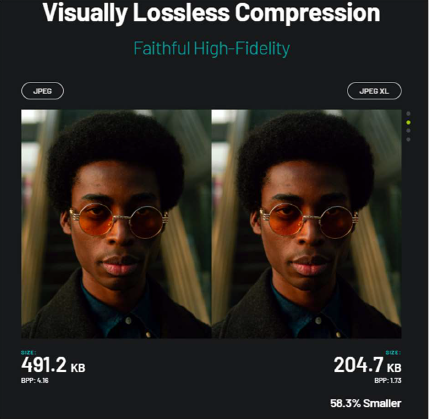
Visually Lossless Compression up to 65% smaller
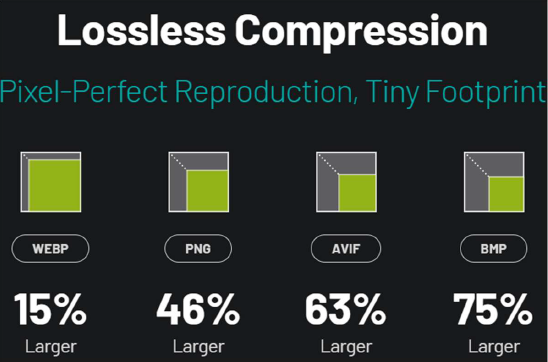
Lossless Compression. Tiny Footprint.
3. Lossless Compression for Critical Applications
Unlike older formats, JPEG-XL offers true lossless compression, which is crucial for certain industries and use cases. PDF documents that contain images requiring perfect preservation—such as medical imaging, legal documents, or archival records—would greatly benefit from the ability to store images without any loss of data.
Migrating to JPEG XL reduces storage costs because servers can store a single JPEG XL file to serve both JPEG and JPEG XL clients. Existing JPEG files can be losslessly transcoded to JPEG XL, significantly reducing their size. These can be restored into the exact same JPEG file, ensuring backward compatibility with existing JPEG-based applications. This provides a smooth transition from legacy JPEG platforms to the modern JPEG XL. Both the transcoding and restoration are computationally efficient.
Lossless JPEG-XL compression in PDFs ensures that the original content is preserved without bloating file sizes, a key advantage for:
- Healthcare documents requiring medical image integrity.
- Archival projects that rely on precise image reproduction.
- Legal documents where document fidelity is critical for compliance.
4. Efficient Handling of Large and High-Resolution Images
PDFs frequently contain large-scale images, especially in industries such as architecture, engineering, and publishing. JPEG-XL excels at handling very large images—up to 1 million x 1 million pixels—without compromising on compression efficiency or image quality. This makes it ideal for:
- CAD and architectural documents, where fine details must be preserved.
- High-resolution technical diagrams that benefit from lossless or near-lossless compression.
- Scientific and geographic data, where file size and image fidelity are critical for analysis and sharing.
3. Lossless Compression for Critical Applications
Unlike older formats, JPEG-XL offers true lossless compression, which is crucial for certain industries and use cases. PDF documents that contain images requiring perfect preservation—such as medical imaging, legal documents, or archival records—would greatly benefit from the ability to store images without any loss of data.
Migrating to JPEG XL reduces storage costs because servers can store a single JPEG XL file to serve both JPEG and JPEG XL clients. Existing JPEG files can be losslessly transcoded to JPEG XL, significantly reducing their size. These can be restored into the exact same JPEG file, ensuring backward compatibility with existing JPEG-based applications. This provides a smooth transition from legacy JPEG platforms to the modern JPEG XL. Both the transcoding and restoration are computationally efficient.
JPEG-XL’s support for progressive decoding also allows for faster rendering of large images, improving the user experience in PDF viewers.
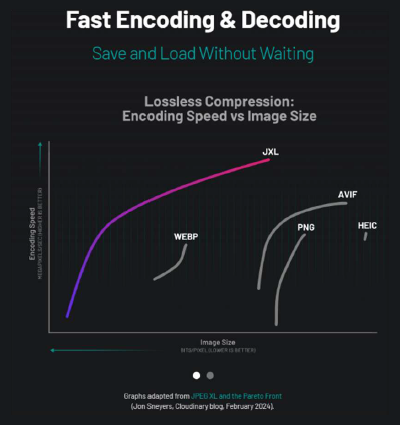
Lossless Compression
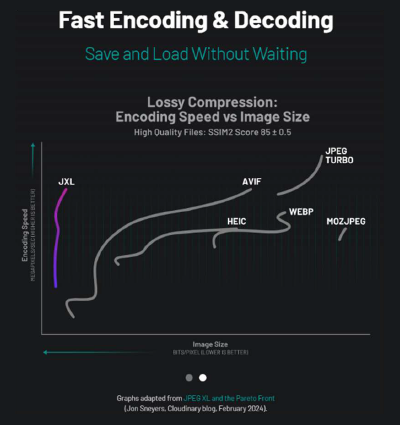
Lossy Compression
5. Energy and Computational Efficiency
JPEG-XL is optimized for modern hardware and software environments, reducing the computational overhead of both encoding and decoding images. This results in:
- Faster rendering times in PDF viewers, particularly on mobile devices or lowerpowered systems.
- Reduced processing load, which can be particularly beneficial in cloud-based document management systems.
- Energy efficiency, contributing to greener, more sustainable IT operations.
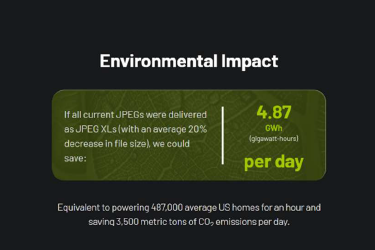
This improved efficiency makes PDFs more responsive across all platforms, enhancing the user experience while reducing system resource usage. In fact, if all current JPEGs were delivered as JPEG XLs (with an average 20% decrease in file size), we could save the equivalent to powering 487,000 average US homes for an hour and saving 3,500 metric tons of CO2 emissions per day.
6. Lossless Long-Term Archiving of Smartphone Photos
With the growing reliance on smartphones for everyday image capture, long-term archival solutions for these images have become a priority. JPEG-XL, with its lossless compression capabilities, is ideally suited for the archiving of smartphone photos within PDFs, offering a solution that preserves image quality while significantly reducing file sizes.

As more users generate large volumes of high-resolution images via smartphones, the need for long-term storage without sacrificing image quality becomes essential. Incorporating JPEG-XL into PDFs provides several key benefits for photo archiving:
- Lossless image preservation: JPEG-XL ensures that smartphone photos are archived without any loss in quality, retaining every pixel of the original image. This is especially important for personal, historical, or professional archives where image integrity must be maintained over time.
- Efficient storage: High-resolution smartphone photos can be significantly reduced in size without sacrificing quality, allowing for more efficient storage and transmission. This is critical for cloud storage services, personal archives, or professional repositories.
- Long-term viability: JPEG-XL is designed with future-proofing in mind, ensuring that archived images remain accessible and compatible with modern and future technologies.
By leveraging JPEG-XL, the PDF standard could transform into a powerful tool for individuals and organizations looking to archive vast libraries of smartphone photos without sacrificing quality or efficiency.
7. Future-Proofing PDF for Modern Digital Workflows
JPEG-XL is gaining adoption in web technologies and digital media applications, and integrating it into the PDF standard would ensure compatibility with next-generation platforms. As more industries transition to using modern image formats, adding JPEG-XL to PDF would:
- Ensure compatibility with future web and mobile technologies.
- Allow for seamless integration between PDF-based workflows and modern digital ecosystems.
- Future-proof the PDF format, ensuring that it remains relevant and efficient for decades to come.
This ensures that PDFs can continue to evolve alongside other technologies, providing users with the best possible document experience.
Benefits for PDF/Raster
PDF/Raster, a subset of PDF designed for scanned image-based documents, would particularly benefit from the addition of JPEG-XL. In industries where scanning and archiving of paper documents are essential—such as healthcare, legal, and government—JPEG-XL’s superior compression and image quality would reduce storage costs and improve the long-term accessibility of these documents.
For large-scale scanning projects, integrating JPEG-XL into PDF/Raster would provide:
- Significant storage savings, especially for long-term archival systems.
- Improved image quality for scanned documents, ensuring that even lowerresolution scans maintain clarity.
- Faster document retrieval and transmission, helping organizations manage large document repositories more efficiently.
By updating PDF/Raster to support JPEG-XL, industries relying on scanned documents would experience a notable boost in efficiency and cost-effectiveness.
Conclusion
The inclusion of JPEG-XL in the ISO PDF standard and PDF/Raster addresses the longstanding limitations posed by the reliance on outdated image codecs. With its superior compression ratios, enhanced image quality, lossless compression, and modern feature set, JPEG-XL is the ideal solution for today’s increasingly complex and image-heavy document workflows.
By integrating JPEG-XL, PDF can evolve to meet the demands of modern digital document management, ensuring smaller file sizes, better image quality, and improved efficiency. This move would not only enhance the user experience but also enable better long-term archiving solutions, especially for smartphone-generated images, and ensure the PDF standard remains compatible with future technological advancements.
TWAIN Working Group supports the adoption of JPEG-XL into the ISO PDF standard as a crucial step towards modernizing the format and unlocking its full potential for industries worldwide.
Sources:
About The TWAIN Working Group
The TWAIN Working Group, established in 1992, is a not-for-profit association of industry leaders who have gathered to create a standard that benefits the imaging industry as a whole. TWAIN’s purpose is to provide and foster a universal public standard which links applications and image acquisition devices. The ongoing mission of this organization is to continue to enhance the standard to accommodate future technologies. TWAIN generates multiple opportunities for application developers and users to access information and broaden the standard; through a developer’s forum, main website and online self-certification process. Current members of the TWAIN Working Group include ExactCODE GmbH, JSE Imaging Solutions, P3iD Technologies Inc., PFU America Inc., a Ricoh Company, Kodak Alaris, InoTec – a Datawin GmbH brand, Plustek, Inc., Atalasoft, Microtek, Inc., Dynamsoft, Epson America, Inc., LEAD Technologies and Hewlett Packard, along with Liaison Partners PDF Association, AIIM International, RISC International and C2PA. More information about TWG Developers Day participation and sponsorship, PDF/R, the TWAIN Direct API and imaging standards can be obtained at pdfraster.org, twain.org and twaindirect.org.